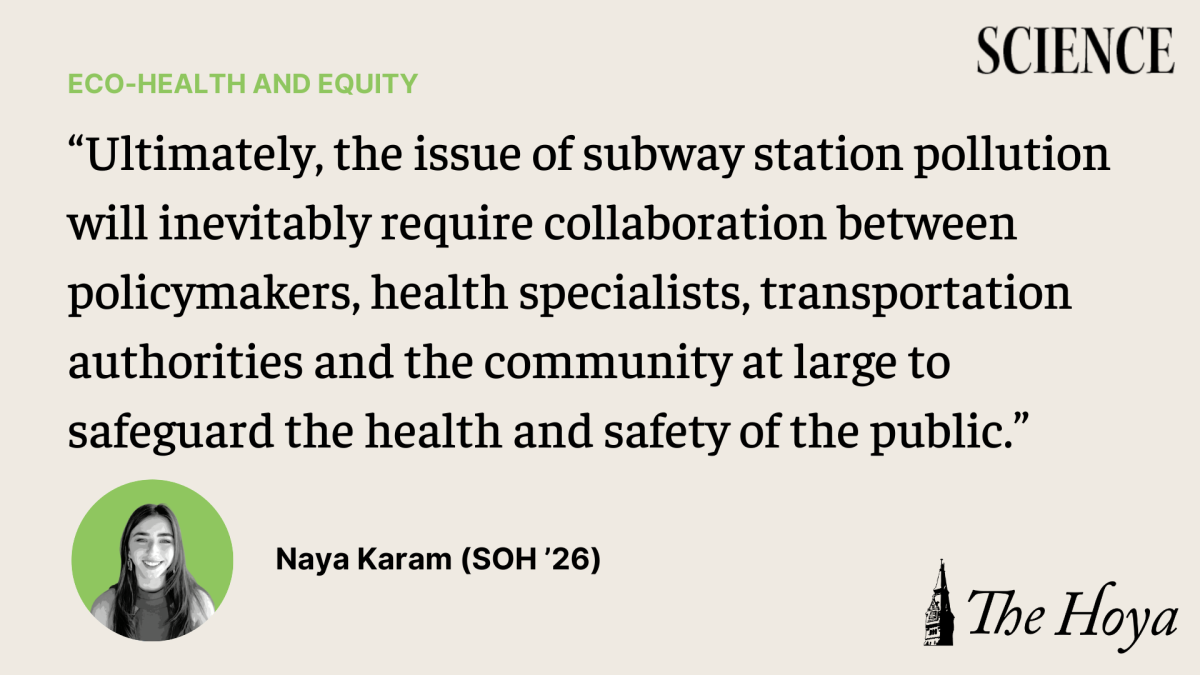The Washington, D.C. Metro trains are seen by many as a sustainable alternative to driving when it comes to reducing carbon emissions, decreasing the amount of carbon-emitting vehicles on the road. According to the National Institutes of Health, subways reduce air particulates by about 4% in highly populated areas like metropolitan D.C. Despite associated popular sentiment, the environmental impact of Metro trains is not so clear-cut. While subway trains seem to be relatively environmentally friendly on the macro scale, the pollution levels of individual subway stations remain high, posing health risks, especially for those who often have no choice but to rely on the subway for transportation.
Research shows that people are being exposed to unsafe levels of pollution in subway stations across major U.S. cities, but the problem is especially concerning in the District. Researchers at New York University Langone Health explain that this pollution is due to factors such as poor ventilation in stations and debris from the skidding of train wheels on the track.
When measuring for the amount of fine particulates — pollutants with a diameter of 2.5 micrometers or less — in the subways, the District was found to have levels of 145 micrograms per cubic meter, well above the 35 micrograms per cubic meter that experts usually regard as being safe. Out of the regions studied by researchers at New York University Langone, air pollution levels in D.C.’s Metro stations were second only to the subway stations of New York City, with D.C.’s Capitol South station being one of the most polluted stations in the Northeast.
Continual exposure to air pollution has been linked to adverse health effects, such as stroke, ischaemic heart disease and lung cancer. This is especially true of exposure to fine particulate matter, such as the type being seen in subways systems throughout the nation, due to their ability to penetrate deep into the lungs and therefore the bloodstream.
These health risks pose a massive problem to those who rely on the subway system to commute to essential places, such as school or work. Individuals who do not own a car do not have the luxury of avoiding the hazardous subway air by deciding to drive. Aside from commuters, these dangerous pollutants also affect those who work in the subways. Workers such as cleaners, train operators and security guards inhale this particulate matter for hours every day, meaning their exposure levels — and consequent health risks — are considerably higher than those of commuters.
Fortunately, there are mitigation efforts that can and should be made to better the subway station air quality of the District and of U.S. cities as a whole. For example, the Washington Metropolitan Area Transit Authority already filters the air in its buses and trains, which rids the air inside the vehicles of 98% of pollutants. While this is great news, it still does not account for the air in the stations themselves. Of course, in order to remedy this situation, large-scale efforts would have to be made, such as making the switch to electric trains or trains that run on renewable energy in the same way that cities like Tokyo have. Unfortunately, due to various political and economic factors, such as the cost of electrifying trains and lobbying by rail companies like Norfolk Southern, it is unlikely that this switch would be made anytime in the near future.
In the meantime, the Metro buses can serve as an effective alternative to the trains, with outdoor stations reducing exposure to pollutants. Additionally, 90% of D.C.’s bus fleets now consist of hybrid vehicles, an effort to keep the air clean. Ultimately, the issue of subway station pollution will inevitably require collaboration between policymakers, health specialists, transportation authorities and the community at large to safeguard the health and safety of the public.









